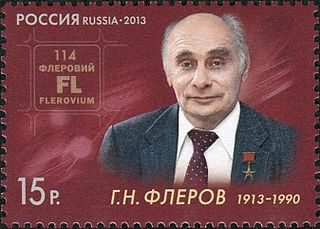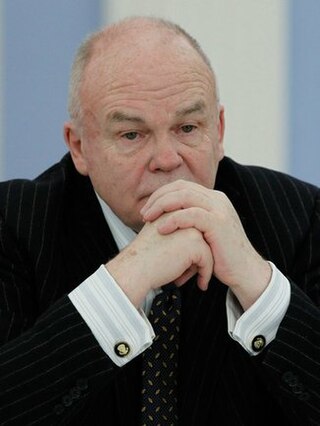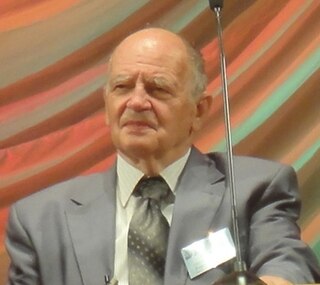Awards
- 1953: Medal "For Labour Valour" & Stalin Prize 2nd Degree.
- 1958: Lenin Prize.
- 1956, 1975, 1981: Order of Lenin.
- 1976: Order of the October Revolution.
- 1971: Hero of Socialist Labour.
- 1985: Order of the Patriotic War 2nd Degree.
Mikhail Petrovich Shumayev (22 April 1924 - 5 February 1995) was a Soviet nuclear physicist, engineer and chemist. He was a co-developer of the RDS-37, the Soviet Union's first two-stage thermonuclear bomb.
He was born in Bol'shiye Alabukhi, Gribanovsky District, Voronezh Oblast. He left high school in 1941 and worked on a farm collective. From 1942, he fought on the Eastern Front (World War II) and was involved in the defence of Stalingrad. He was discharged after being wounded in February 1943. [1]
Between 1944 and 1945, he studied at the Ivanovo Institute of Chemical Technology before transferring to Moscow State University to study physics, graduating with honours in 1950. He was sent to KB-11, now the All-Russian Scientific Research Institute of Experimental Physics in the closed city of Sarov, Nizhny Novgorod region, where he worked as a senior engineer on thermonuclear weapons in Igor Tamm's group. This group developed, tested and improved megatonne-yield thermonuclear weapons. In 1955, he transferred to the Scientific Research Institute-1011. Later, his working group developed nuclear charges for an aerial bomb, the R-13 rocket and the X-20M cruise missile. For this work in equipping bombs and missile systems, he and his colleagues received the Lenin Prize in addition to other state awards for their involvement in the development of his country's nuclear defences. He wrote a further degree thesis in 1960 and was awarded a Ph.D. in 1968. Later he became head of the theoretical department of the 1011 group, a role he remained in until 1990, when he became a chief researcher. He trained many scientists and was part of the committees and commissions which awarded state prizes, degrees and titles related to his areas of expertise. He retired in August 1991. [2] [1] [3]
He died in Obninsk, Kaluga Oblast. [1]

Vitaly Lazarevich Ginzburg, ForMemRS was a Russian physicist who was honored with the Nobel Prize in Physics in 2003, together with Alexei Abrikosov and Anthony Leggett for their "pioneering contributions to the theory of superconductors and superfluids."

The Lenin Prize was one of the most prestigious awards of the Soviet Union for accomplishments relating to science, literature, arts, architecture, and technology. It was originally created on June 23, 1925, and awarded until 1934. During the period from 1935 to 1956, the Lenin Prize was not awarded, being replaced largely by the Stalin Prize. On August 15, 1956, it was reestablished, and continued to be awarded on every even-numbered year until 1990. The award ceremony was April 22, Vladimir Lenin's birthday.

Georgii Nikolayevich Flyorov was a Soviet physicist who is known for his discovery of spontaneous fission and his important contribution towards the crystallography and material science, for which, he was honored with many awards. In addition, he is also known for his letter directed to Joseph Stalin, during the midst of World War II, to start the Soviet program of nuclear weapons in the former Soviet Union.

Evgeny Pavlovich Velikhov is a physicist and scientific leader in the Russian Federation. His scientific interests include plasma physics, lasers, controlled nuclear fusion, power engineering, and magnetohydrodynamics. He is the author of over 1500 scientific publications and a number of inventions and discoveries.
Yevgeny Ivanovich Zababakhin was a Soviet military engineer, theoretical physicist and one of the chief designers of nuclear weapons in the USSR. Amongst many others, he was involved in the first Soviet nuclear bomb (RDS-1) and the design of the first Soviet two-stage hydrogen bomb (RDS-37).

Kirill Ivanovich Shchelkin was a Soviet physicist of Georgian origin in the former Soviet program of nuclear weapons who made theoretical and experimental contribution in combustion and gas dynamics.

Yuri Alexeyevich Trutnev was a Russian physicist and a professor of engineering at the National Research Nuclear University MEPhI.

Aleksandr Davidovich Nadiradze was a Soviet engineer of Georgian ethnicity who was instrumental in former Soviet Union's aerospace and defense technology. He developed various missiles, bombs, shells and is considered "father" of the mobile ICBMs, having created the RT-21 Temp 2S (SS-16), RSD-10 Pioneer (SS-20) and the RT-2PM Topol (SS-25). More modern weapons such as the RT-2PM2 Topol-M and RS-24 are mostly based on Nadiradze's work as well.

All-Russian Scientific Research Institute Of Technical Physics (VNIITF) is a research institute based in Snezhinsk, Russia. It was previously also known as NII-1011.
German Arsenyevich Goncharov was a Russian physicist whose career mostly spent in the former Soviet program of nuclear weapons. Since 1952 until 2004, Goncharov developed and tested Soviet thermonuclear weapons and led a theoretical department at the Soviet nuclear research facility at Arzamas-16 from 1967 to 2004.
Vyacheslav Petrovich Feodoritov (February 28, 1928 - January 2, 2004), k.N, was a Russian physicist in the former Soviet program of nuclear weapons. He was a co-designer of the first two-stage Soviet thermonuclear device, the RDS-37, and became a chief of laboratory at Arzamas-16, now known as the All-Russian Scientific Research Institute of Experimental Physics.
Yuri Nikolayevich Babayev, k.N, was a Soviet physicist who spent a long career in the former Soviet program of nuclear weapons, and known as one of the principles who designed the Tsar Bomba, the largest-ever nuclear weapon.
Yuri Alexandrovich Romanov was a Russian physicist who spent his career in the former Soviet program of nuclear weapons.
Viktor Borisovich Adamskyk.N was a Russian physicist of Ukrainian origin known for his work on the former Soviet program of nuclear weapons.

Yevgeny Nikolayevich Avrorin, D.N, was a Russian physicist whose career was spent in the former Soviet program of nuclear weapons.
Vitaliy Aleksandrovich Aleksandrovich (Russian:Виталий Александрович Александрович; 14 February 1904 – 12 July 1959) was a Ukrainian Soviet physical chemist and chemical engineer who also became part of the Soviet programme that developed nuclear weapons from the late 1940s. He was a co-author of the design report of the first Soviet two-stage thermonuclear bomb, the RDS-37.

Viktor Aleksandrovich Davidenko was a Soviet military engineer and mathematical physicist, whose research significantly enhanced the development of Soviet nuclear weapons during the Soviet atomic bomb project of 1942–1949.
Ekaterina Alekseevna Feoktistova was a Ukrainian Soviet chemist, engineer, physicist and explosives expert. She worked on the Soviet atomic bomb project from 1947 until her retirement, leading a laboratory from 1952.

Arkady Adamovich Brish was a Soviet and Russian physicist, a designer of nuclear weapons, Doctor of Sciences, professor, Hero of Socialist Labour, Laureate of the Lenin Prize and the USSR State Prize.
Mikhail Aleksandrovich Bibikin was a Soviet design engineer, a specialist in the development of nuclear weapons, and a USSR State Prize Laureate (1971).